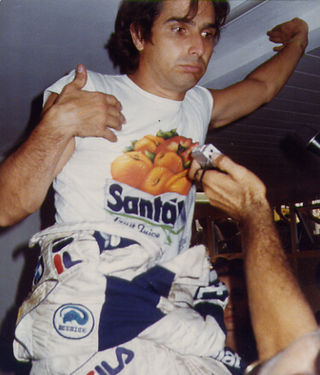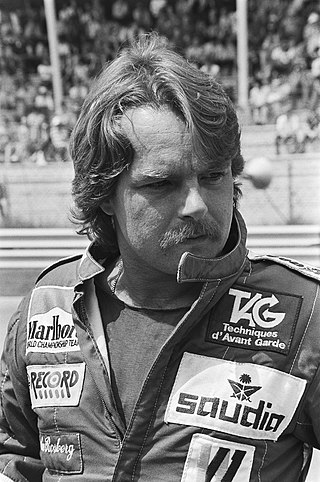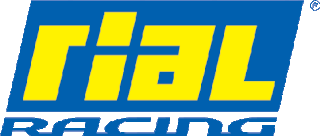
Riccardo Gabriele Patrese is an Italian former racing driver, who raced in Formula One from 1977 to 1993.

Andrea de Cesaris was an Italian racing driver. He started 208 Formula One Grands Prix but never won, meaning he held the record for the most races started without a race victory from 1991 until Nico Hülkenberg surpassed his total at the 2024 Miami Grand Prix. A string of accidents early in his career earned him a reputation for being a fast but wild driver.

The 1983 FIA Formula One World Championship was the 37th season of FIA Formula One motor racing. It featured the 1983 Formula One World Championship for Drivers and the 1983 Formula One World Championship for Manufacturers, which were contested concurrently over a fifteen-race series that commenced on 13 March and ended on 15 October.

The 1982 FIA Formula One World Championship was the 36th season of FIA Formula One motor racing. It included two competitions run over the course of the year, the 33rd Formula One World Championship for Drivers and the 25th Formula One World Championship for Constructors. The season featured sixteen rounds between 23 January and 25 September. The Drivers' Championship was won by Keke Rosberg and the Constructors' Championship by Scuderia Ferrari.
Osella is an Italian racing car manufacturer and former Formula One team. They participated in 132 Grands Prix between 1980 and 1990. They achieved two points finishes and scored five world championship points.
Motori Moderni was a Formula One engine manufacturer from 1985 through 1987. It was established in Novara by Italian engine designer Carlo Chiti.

The 1982 United States Grand Prix West was a Formula One motor race held on April 4, 1982, at the temporary street circuit at Long Beach, California.

Rial is a German producer of light alloy wheels and rims, and was a Formula One constructor competing in the 1988 and 1989 seasons. Founded in the 1970s as a wheel rim producer, the company was bought by Günter Schmid, ex-owner of the ATS wheels company in 1987. Schmid followed the same strategy as he had at ATS, advertising the Rial wheel brand by entering Formula One as a constructor. Rial participated in 32 Grands Prix, entering a total of 48 cars. They scored six championship points, finishing a highest of ninth in the constructors championship in 1988. After leaving Formula One at the end of the 1989 season, the Rial Racing division was closed, and the company did not race again. Rial continues to manufacture wheels and rims from its factory in Fußgönheim.

The Brabham BT49 is a Formula One racing car designed by South African Gordon Murray for the British Brabham team. The BT49 competed in the 1979 to 1982 Formula One World Championships and was used by Brazilian driver Nelson Piquet to win his first World Championship in 1981.

Carlo Chiti was an Italian racing car and engine designer best known for his long association with Alfa Romeo's racing department. He also worked for Ferrari and was involved in the design of the Ferrari 156 Sharknose car, with which Phil Hill won the 1961 championship.

The Alfa Romeo 179 is a Formula One car which was used by the Alfa Romeo team from 1979 to 1982. The 179 made its debut at the 1979 Italian Grand Prix, replacing the flat-12 engined Alfa Romeo 177. During its lifespan there were many versions and 179D version was used for the last time at the 1982 South African Grand Prix.

The Alfa Romeo 158/159, also known as the Alfetta, is a Grand Prix racing car produced by Italian manufacturer Alfa Romeo. It is one of the most successful racing cars ever; the 158 and its derivative, the 159, took 47 wins from 54 Grands Prix entered. It was originally developed for the pre-World War II voiturette formula (1937) and has a 1.5-litre straight-8 supercharged engine. Following World War II, the car was eligible for the new Formula One introduced in 1947. In the hands of drivers such as Nino Farina, Juan Manuel Fangio and Luigi Fagioli, it dominated the first two seasons of the World Championship of Drivers.

The Alfa Romeo 177 was a Formula One car used by the Alfa Romeo team during the 1979 Formula One season, debuting at the 1979 Belgian Grand Prix. The 177 marked Alfa Romeo's return to Formula One, 28 years after winning the World Drivers' Championship titles in 1950 and 1951.

The Alfa Romeo 184T is a Formula One car which was used by the Alfa Romeo team during the 1984 and 1985 Formula One seasons.

The Alfa Romeo 183T was a Formula One car designed by Gérard Ducarouge and Mario Tollentino and was used by Marlboro Team Alfa Romeo during the 1983 Formula One season. The car, with a newly designed flat bottom, made its debut at the 1983 Brazilian Grand Prix. Running on Michelin tyres, the 183T was driven in 1983 by Italian drivers Andrea de Cesaris and Mauro Baldi.
Italian motor manufacturer Alfa Romeo has participated multiple times in Formula One. The brand has competed in motor racing as both a constructor and engine supplier sporadically between 1950 and 1987, and later as a commercial partner between 2015 and 2023. The company's works drivers won the first two World Drivers' Championships in the pre-war Alfetta: Nino Farina in 1950 and Juan Manuel Fangio in 1951. Following these successes, Alfa Romeo withdrew from Formula One.
Gérard Ducarouge was a French Formula One car designer whose career in motorsport started in 1965 when he joined the French constructor and racing team Equipe Matra Sports. He designed the Matra MS80 car which, entered by the British privateer Matra International team of Ken Tyrrell, won both the World Drivers' Championship and World Constructors' Championship in the 1969 season. After leaving Matra he also designed cars for Ligier and Lotus which won several races in the 1970s and 1980s.

The Brabham BT50 was a Formula One racing car designed by Gordon Murray and powered by a turbo BMW engine. It was raced by the Brabham team, owned by Bernie Ecclestone, during the 1982 Formula One season. Driven by Nelson Piquet and Riccardo Patrese, it made its debut at the South African Grand Prix before being withdrawn for further development of its engine while the team reverted to the previous year's car, the Brabham BT49. On the reintroduction of the BT50, Piquet finished fifth in the Belgian Grand Prix. A few races later he drove it to a win in the Canadian Grand Prix. Later in the year it achieved three more finishes in the points for the team. During the second half of the season, Brabham implemented the strategy of mid-race refueling. This allowed Piquet and Patrese to start the races relatively light and use their reduced weight to gain track position over their competitors before stopping to refuel. The poor reliability of the BT50 meant that they had only a few opportunities to demonstrate the strategy in practice.

The Cooper T86 was a Formula One racing car built by Cooper and first raced in 1967. B and C specification cars were also built to accommodate different engines, but the car could not revive Cooper's fortunes and this type represents the last Formula One chassis built and raced by the former champion team.
Alfa Romeo made a series of 2.1-litre to 3.0-litre, naturally-aspirated and turbocharged, V-12 and flat-12, Grand Prix and Sports car racing engines designed for Formula One, the World Sportscar Championship, Can-Am, the Nordic Challenge Cup, and Interserie; starting in 1973, with their Alfa Romeo 33TT12 Group 5 sports car. This was followed by the twin-turbocharged Alfa Romeo 33SC12 Group 6 engine in 1976, and shortly after, Brabham as an engine supplier in 1976; before entering Formula One themselves in 1979. Their first was a Carlo Chiti-designed Alfa Romeo flat-12 engine which had been used earlier in the Alfa Romeo 33TT12 and 33SC12 sports cars. In 1976 this engine was supplied to Brabham and the deal continued until 1979. The engine was dubbed the 115-12, and was a 180° V12 engine; essentially making it a flat-12 engine. Their second 12-cylinder engine, dubbed the 1260, debuted at the 1979 Italian Grand Prix. This time, the engine configuration was a conventional 60° V-12, rather than a flat layout.

















